Published 15:55 IST, July 8th 2020
Fireworks from space: Fascinating images of comet NEOWISE as seen from space & Earth
Comet NEOWISE was seen from space as and here are images of fireworks from space as shared by Astronaut Bob Behnken. Read on for more details.

The NEOWISE comet is the third comet discovered this year and has been fascinating sky watchers ever since. The comet was first discovered on March 27th, 2020 using a NEOWISE (Near-Earth Object Wide-field Infrared Survey Explorer) space telescope. Recently, Astronaut Bob Behnken shared few images of the Comet NEOWISE. The pictures have been going viral on social media, check them out below.
Fireworks from space and comet NEOWISE visibility
Astronaut Bob Behnken, who is currently aboard the International Space Station (ISS), tweeted images of the NEOWISE Comet. The astronaut called the scene a night of fireworks. He credited science for the fascinating view and shared images of the same on his social media handles. Check out the images below.
The post went viral on the internet and received 32 thousand likes and 4.3 thousand retweets. Several other sky watchers also shared their images and the view that they captured. Take a look at them below.
International Space station twitter
Some Images clicked by Jereme Perez of the C/2020 F3 Comet NEOWISE
NEOWISE comet video by Michael Jäger
Ivan Vagner twitter
Dates: When can you see comet NEOWISE again?
By around Jul 11, the comet will reach an altitude of nearly 10 degrees. Over the next 10 days, it will slide back down towards the north-east horizon gradually. Eventually, the comet will disappear from dawn visibility.
On July 12, a better viewing perspective will become available. During the evening sky, the comet will appear low in the northwest sky. The following evenings, the comet will rapidly climb higher in the sky.
NEOWISE will be the closest the Earth on July 22nd. It will be visible to skywatchers from the closest distance as the NEOWISE comet will be at about 64 million miles (103 million KM) away from the earth. It will give a fascinating view to skywatchers.
Another date that NEOWISE comet will reportedly be visible to the skywatchers is July 25th. The comet shall appear 30 degrees up from the west-northwest horizon as the sun sets. The NEOWISE comet will be visible again for spotting in the sky on the 30-31st of July. According to a media portal, the comet will be passing just to the north of the fine star cluster of Coma Berenices or Berenice's Hair.
How to see NEOWISE comet
According to a media portal, the comet will grow faint in the following days. However, it will be farther away from the sun, so it will be visible in against a darker sky. Around the beginning of August, the comet will be very well placed for skywatchers and observers with small telescopes.
Reportedly, even amateur observers will be able to get favourable conditions to see the comet. However, the visibility of such bright comets is subject to other factors as well. Factors including clouds, haze, pollution, city lights or even moonlight can affect its visibility. Binoculars or telescopes can enhance the view.
Image credits: ISS Twitter and Chris Schur Astrography
Updated 15:55 IST, July 8th 2020



